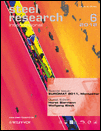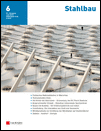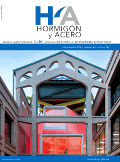
International Journal of Steel Structures
Scope & Guideline
Innovative Insights into Steel Structures
Introduction
Aims and Scopes
- Structural Behavior and Performance Analysis:
Research addressing the behavior of steel structures under various loading conditions, including static, dynamic, and seismic loads. This includes studies on connections, joints, and overall structural integrity. - Material Properties and Innovations:
Exploration of the mechanical properties of different steel grades and composites, with an emphasis on innovative materials and surface treatments that enhance durability and performance. - Design Methodologies and Optimization:
Development of advanced design methodologies and optimization techniques for steel structures, focusing on efficiency, safety, and sustainability in engineering practices. - Numerical and Experimental Techniques:
Utilization of numerical methods, such as finite element analysis, combined with experimental validation to understand complex behaviors of steel structures and components. - Corrosion and Fatigue Studies:
Investigations into the effects of corrosion and fatigue on the longevity and reliability of steel structures, including innovative repair and retrofitting techniques.
Trending and Emerging
- Sustainability and Green Engineering:
There is a growing emphasis on sustainable practices in steel construction, including studies on recycled materials, energy-efficient designs, and life-cycle assessments of steel structures. - Advanced Seismic Resilience:
Research focusing on enhancing the seismic resilience of structures is on the rise, with innovative design concepts, such as self-centering systems and energy dissipation devices gaining attention. - Integration of Smart Technologies:
The integration of smart technologies, including sensors and monitoring systems, into steel structures for real-time performance assessment and maintenance optimization is increasingly prevalent. - Machine Learning Applications:
The application of machine learning techniques for predictive modeling and optimization in steel structures is emerging as a significant trend, offering new methods for analyzing complex structural behaviors. - Hybrid and Composite Systems:
There is an increasing interest in hybrid systems that combine steel with other materials, such as concrete and composites, to improve structural performance and resilience under various loading conditions.
Declining or Waning
- Traditional Connection Details:
Studies focusing on conventional bolted or welded connections are becoming less frequent as researchers shift towards more innovative connection systems that offer improved performance and resilience. - Basic Structural Analysis Methods:
There is a noticeable decline in papers utilizing basic structural analysis methods, as the field moves towards more sophisticated computational techniques and simulation-based analyses. - Generalized Seismic Design Approaches:
Research pertaining to generalized seismic design approaches is waning, potentially due to the increasing complexity and specificity required in modern seismic evaluations. - Single Material Studies:
Papers focusing solely on conventional steel without considering composite or hybrid materials are less common, indicating a trend towards multi-material studies that enhance structural performance.
Similar Journals

STRENGTH OF MATERIALS
Advancing the frontiers of material strength research.STRENGTH OF MATERIALS is a prestigious journal published by SPRINGER that focuses on the critical field of mechanics of materials, providing an authoritative platform for the dissemination of research and developments in material strength analysis since 1969. With an ISSN of 0039-2316 and an E-ISSN of 1573-9325, this journal serves a global audience of researchers, professionals, and students, contributing essential insights into the physical properties and performance characteristics of various materials under stress and strain. As part of the United States' academic literature, it showcases work that not only advances theoretical knowledge but also applies to practical engineering scenarios. Although ranked in the Q4 tier with respect to its category in Mechanics of Materials, with a Scopus rank of #319 out of 398 (19th percentile), it remains an important resource for those looking to expand their understanding in this specialized area. Researchers can access a wealth of information through this journal, fostering continued innovation and interdisciplinary collaboration.

Journal of Constructional Steel Research
Unlocking Potential Through Rigorous ResearchJournal of Constructional Steel Research, published by Elsevier Ltd, stands as a leading platform in the realm of constructional steel research since its inception in 1980. With a robust focus on Building and Construction, Civil and Structural Engineering, Mechanics of Materials, and Metals and Alloys, this prestigious journal has earned its place in the Q1 category across multiple disciplines, symbolizing excellence in scholarly contributions. The journal's impressive Scopus rankings further underscore its significance, ranking 30th out of 223 in Building and Construction, and exhibiting strong standings in other related fields. Researchers, professionals, and students will find this publication an invaluable resource, offering access to the latest findings and innovations in constructional steel, necessary for advancing practices in engineering and material sciences. Although it does not operate under an open-access model, the content is meticulously curated to ensure high-quality, peer-reviewed research, continuing to shape the future of steel construction methodologies.

Magazine of Civil Engineering
Advancing Civil Engineering Knowledge for Tomorrow's InfrastructureMagazine of Civil Engineering, published by ST-PETERSBURG STATE POLYTECHNICAL UNIVERSITY, is a prominent open access journal dedicated to the field of civil and structural engineering. With an ISSN of 2712-8172 and E-ISSN 2071-0305, it serves as a vital platform for disseminating high-quality research, innovative methodologies, and current trends in building and construction. Since its inception in 2010, the journal has embraced open access, ensuring broad visibility and accessibility for its contributions to the academic community. The magazine holds a respectable position in the academic hierarchy, ranked in the Q3 quartile for both Building and Construction and Civil and Structural Engineering categories as of 2023. It is indexed in Scopus, amplifying its societal impact and reach with a rank of #114/223 in Building and Construction and #224/379 in Civil and Structural Engineering. Researchers, professionals, and students alike are encouraged to engage with the cutting-edge studies presented in the magazine, contributing to the advancement of knowledge and practice within the civil engineering domain.

WIND AND STRUCTURES
Innovative Insights: Shaping the Future of Structural EngineeringWIND AND STRUCTURES is an esteemed peer-reviewed journal dedicated to advancing knowledge in the fields of building and construction, civil and structural engineering, and modeling and simulation. Published by TECHNO-PRESS and based in South Korea, this journal has made significant contributions to its discipline since its inception in 1998, maintaining a strong focus on innovative research up to 2024. With an ISSN of 1226-6116 and an E-ISSN of 1598-6225, it has established a notable presence in academic circles, evidenced by its Scopus rankings which position it within the mid-range percentile among its peers. The journal is classified in the Q3 quartile for 2023 in key categories including Building and Construction, Civil and Structural Engineering, and Modeling and Simulation, highlighting its relevance and importance in contemporary research. While it does not provide open access, WIND AND STRUCTURES continues to be a vital resource for researchers, professionals, and students eager to explore cutting-edge advancements and methodologies in structural resilience against environmental forces.

STEEL RESEARCH INTERNATIONAL
Advancing the Future of Metals and Alloys.STEEL RESEARCH INTERNATIONAL, published by WILEY-V C H VERLAG GMBH, is a premier journal that serves as a vital source of knowledge in the fields of condensed matter physics, materials chemistry, and metal and alloy research. With an ISSN of 1611-3683 and an E-ISSN of 1869-344X, this journal provides open access options that enhance its visibility and accessibility. Recognized for its scientific merit, it currently holds a Q2 ranking across multiple categories including Condensed Matter Physics and Materials Chemistry. This translates to an exceptional placement within the 64th percentile for Metals and Alloys and substantial recognition in other related fields according to Scopus rankings. By bridging theoretical concepts and practical applications, STEEL RESEARCH INTERNATIONAL aims to foster innovative research and dissemination of knowledge among researchers, professionals, and students focused on advancing the metallurgy and materials science domains. With a commitment to remain at the forefront of research from 2003 to 2024, the journal is poised to continue shaping the future of steel and alloy studies.

Stahlbau
Elevating Knowledge in Civil and Structural Engineering.Stahlbau is a prestigious journal published by ERNST & SOHN, focusing on the intersection of materials science, civil engineering, and mechanical engineering. With its roots dating back to 1968 and extensive coverage through 2024, this journal serves as a vital platform for the dissemination of innovative research and insights in the fields of Building and Construction, Civil and Structural Engineering, and Advances in Metals and Alloys. Despite its categorization in the Q3 quartile across several disciplines, it is recognized for its rigorous peer-reviewed articles and its commitment to advancing knowledge in structural engineering and materials' performance. The journal aims to foster a dynamic dialogue among researchers, industry professionals, and students, making it an essential resource for anyone looking to stay at the forefront of developments in construction and materials engineering. Access options reflect a commitment to intellectual exchange in academia, emphasizing the journal's role as a cornerstone for emerging research and best practices.

Hormigon y Acero
Pioneering Research in Structural IntegrityHormigon y Acero, an esteemed journal published by the ASOC ESPANOLA INGENIERIA ESTRUCTURAL-ACHE, serves as a vital resource in the fields of structural engineering and construction. With an ISSN of 0439-5689 and an E-ISSN of 2605-1729, this journal plays a critical role in disseminating innovative research and advancements from 2019 to 2024, particularly focusing on concrete and steel applications. Although it does not currently offer open access, its contributions remain invaluable to professionals and academics seeking to enhance their understanding and practices in engineering disciplines. Ranked within the 13th percentile in Building and Construction and the 9th percentile in Civil and Structural Engineering according to Scopus, Hormigon y Acero is recognized for its rigorous peer-reviewed content that addresses contemporary challenges and innovations within the industry. The journal is positioned in Madrid, Spain, and aims to foster collaboration and knowledge exchange among researchers, practitioners, and students dedicated to the advancement of structural engineering.

Electronic Journal of Structural Engineering
Pioneering Research for Sustainable Infrastructure DevelopmentThe Electronic Journal of Structural Engineering (ISSN: 1443-9255), published by EJSE INT LTD, serves as a vital platform for disseminating innovative research and developments in the field of structural engineering. Since its inception in 2001, the journal has evolved to embrace an Open Access model starting in 2022, ensuring that cutting-edge findings are freely accessible to researchers, professionals, and students worldwide. Housed within the reputable Department of Infrastructure Engineering at the University of Melbourne, Australia, the journal focuses on a wide range of topics related to civil and structural engineering, positioning itself within the Q4 category on the 2023 Scopus rankings. While its H-index and detailed scope data are currently unavailable, the journal's commitment to quality research is evident through its continuous publication and engagement with the global academic community. With significant implications for contemporary engineering practices, The Electronic Journal of Structural Engineering not only fosters scholarly discourse but also encourages practical applications of structural engineering advancements.

ENGINEERING JOURNAL-AMERICAN INSTITUTE OF STEEL CONSTRUCTION
Exploring the Intersection of Design and Engineering Excellence.ENGINEERING JOURNAL-AMERICAN INSTITUTE OF STEEL CONSTRUCTION, published by the American Institute of Steel Construction, stands as a vital resource for researchers, practitioners, and students in the fields of Building and Construction as well as Civil and Structural Engineering. With a history tracing back to its convergence in 1968 and an ongoing commitment to advancing engineering knowledge up to 2024, the journal is indexed under the ISSN 0013-8029. Despite its current open access status, the journal carries significant scholarly weight, reflected in its Q3 ranking in both relevant categories for 2023 and Scopus rankings indicating robust academic relevance within its sectors. The publication aims to disseminate innovative research, practical insights, and critical reviews that contribute to the enhancement of steel construction and infrastructure development. Situated in the heart of Chicago, the journal's dedicated focus on steel's pivotal role in engineering design and application forms an essential part of the conversation around modern building practices and sustainability challenges in the construction industry.

International Journal of Protective Structures
Innovative designs for resilient structures.International Journal of Protective Structures is a leading peer-reviewed publication dedicated to advancing the field of protective structures, focusing on innovative designs and methodologies relevant to future applications in safety, risk management, and materials engineering. Published by SAGE Publications Ltd in the United Kingdom, this journal has established itself as a vital resource for researchers, professionals, and students alike, notably holding a strong presence in Scopus rankings within its categories—including Q2 in Building and Construction, Mechanics of Materials, and Safety, Risk, Reliability and Quality. The journal aims to disseminate high-quality research from 2010 to 2024, emphasizing both theoretical and practical implications in its scope. By offering crucial insights into protective structural development and resilience against various risks, International Journal of Protective Structures plays an important role in shaping the discourse within its fields. With an ongoing commitment to accessibility and knowledge sharing, this journal is indispensable for those striving to innovate and implement safe structural engineering practices.